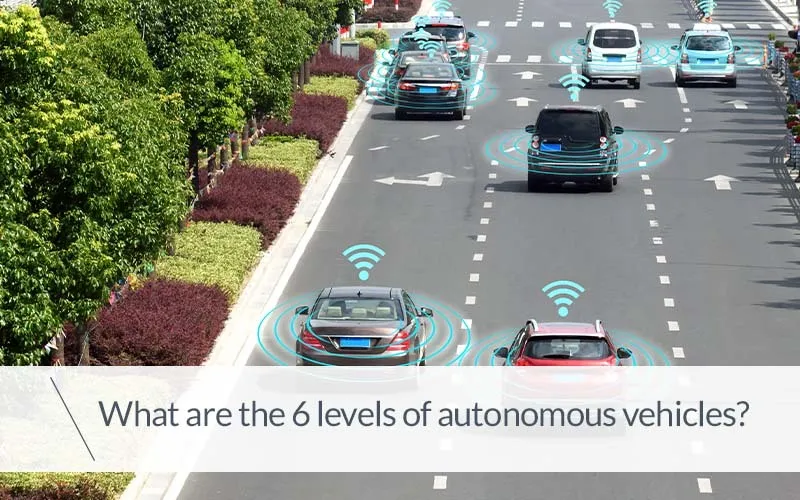
Introduction
The Society of Automotive Engineers (SAE) International has established a global standard for self-driving car technology, classifying them into six distinct levels based on their level of automation. Understanding these Levels of Self-Driving Cars is crucial to navigating the exciting – and sometimes confusing – world of autonomous vehicles.
Follow us on Linkedin for everything around Semiconductors & AI
Level 0: No Driving Automation
Level 0 represents the current state of most cars on the road today. Here, you’re firmly in control, with no self-driving features to assist you.
Some vehicles have anti-lock braking systems (ABS) or traction control, and manufacturers design these as driver-assistance systems to enhance, not replace, your control.
Level 1: Driver Assistance
Level 1 introduces basic driver-assistance features that take some of the workload off your shoulders. These systems can help you with tasks like maintaining a constant speed (cruise control) or alerting you if you unintentionally drift out of your lane (lane departure warning).
While Level 1 features provide some comfort and convenience, it’s important to remember that they are not autonomous. The driver remains fully responsible for operating the vehicle and must be constantly attentive.
Read More:Samsung to Introduce New 3D Packaging SAINT: HBM Goes Vertical – techovedas
Level 2: Partial Driving Automation
Level 2 builds on Level 1 by allowing the car to manage both steering and acceleration/deceleration under specific conditions. This partial automation might involve features like Adaptive Cruise Control (ACC) that adjusts your speed to maintain a safe distance from the car in front, or lane centering that helps keep you within the lane markings.
However, Level 2 doesn’t mean you can kick back and relax. The driver must stay engaged, monitor the road at all times, and be prepared to take back control immediately when necessary.
Tesla’s Autopilot system is an example of Level 2 technology. While it can steer and control speed on highways, it has come under scrutiny for accidents where drivers became overly reliant on the system and failed to take control when needed. This underscores the critical point that Level 2 autonomy is not a set-it-and-forget-it solution.
Level 3: Conditional Driving Automation
Level 3 marks a significant leap forward. Here, the car can handle most driving tasks under certain predefined conditions, like on highways with clear lane markings and predictable traffic flow. Drivers can take their eyes off the road for short periods, but they must prepare to resume control when the car prompts them.
This technology is still under development and not widely available due to the complexity of ensuring drivers remain attentive and prepared to take over.
Read More: Intel 3 Technology Roadmap: A Comprehensive Overview – techovedas
Level 4: High Driving Automation
Level 4 vehicles represent a significant step towards true self-driving cars. These can handle all driving tasks within specifically designated areas, often referred to as geofences. This might include self-contained campuses, designated highway lanes, or mapped urban centers.
Level 4 cars may not have a steering wheel or pedals, as they are not intended for manual control. However, their operational range is limited, and they will disengage if they encounter situations they can’t handle, like unpredictable weather or complex road layouts.
Level 5: Full Driving Automation
Level 5 represents complete autonomy. These vehicles can handle any driving situation, anywhere, without requiring any human input. You get into your car, set your destination, and then kick back and relax as the car takes you away, handling everything.
Read More: Samsung’s 3nm Yield Woes: GAA Gamble Backfires, TSMC Takes the Lead? – techovedas
Roadblocks on the Path to Autonomy
While the concept of self-driving cars is undeniably exciting, the road to widespread adoption is paved with challenges. Here are some of the key hurdles that need to be overcome:
- Sensor Technology: Level 5 autonomy hinges on the car’s ability to perceive its surroundings with unparalleled accuracy. This requires a sophisticated suite of sensors, including LiDAR, radar, and high-resolution cameras. Current sensor technology still struggles with factors like heavy rain, fog, or poor lighting.
- Mapping and Localization: Self-driving cars rely on detailed, high-definition maps to navigate their way. These maps need to be constantly updated to reflect changes in road infrastructure, traffic patterns, and even weather conditions.
- Artificial Intelligence (AI): AI algorithms are responsible for processing sensor data, making driving decisions, and reacting to unexpected situations. Developing robust AI that can handle the immense complexity of real-world driving scenarios is a monumental task.
- Regulation and Legislation: The legal framework governing self-driving cars is still evolving. Questions around liability in case of accidents, standardization of safety protocols, and data privacy concerns need to be addressed before these vehicles can be widely deployed.
Conclusion
The timeline for widespread adoption of self-driving cars remains uncertain. However, ongoing advancements in technology, coupled with a collaborative effort from automakers, tech companies, and policymakers, are steadily propelling us towards a future where driverless vehicles are no longer science fiction, but a reality shaping our everyday lives.








